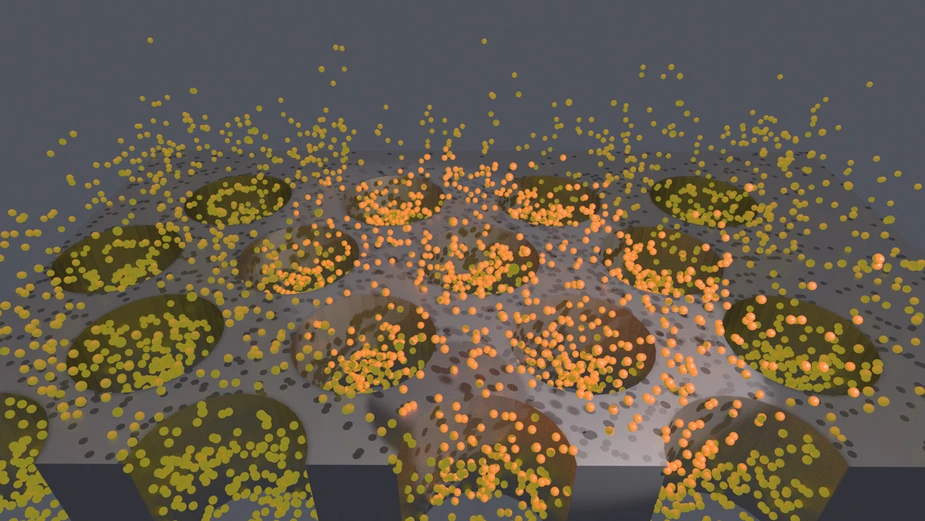Efficient conversion of the wavelength
By “upconversion” of photons, researchers at HZB and BAM achieve an up to a one-thousand-fold increase in the electric field strength of the light waves
The region of the spectrum that can be utilised for producing electrical energy can be considerably extended by converting low-energy (longer wavelength) photons into high-energy (shorter wavelength) photons. But so far, this has only been possible at high intensities of light. Now for the first time, scientists from the Helmholtz-Zentrum Berlin (HZB) and the Federal Institute for Materials Research and Testing (BAM) have been able to produce a usable effect from relatively weak light by combining certain nanoparticles with what is known as a meta-surface. This paves the way for future applications in photovoltaics, for the detection of biological substances, and for electrical-field sensors.
Certain materials possess a special property: They are able to convert light of long wavelengths into much shorter wavelengths. To do this, they combine two or more low-energy photons to form one higher-energy photon. Physicists refer to this as upconversion. In photovoltaics, for example, this effect means possibly utilising previously unused portions of the Sun’s light to generate electrical energy. “In the solar cells used today, which are mostly made of silicon, infrared light at wavelengths of more than about 1,200 nanometres cannot be efficiently converted into electricity and is lost“, says Prof. Dr. Christiane Becker, who heads a Helmholtz Young Investigator Group called Nano-SIPPE at the Helmholtz-Zentrum Berlin für Materialien und Energie (HZB). Upconversion may augment the amount of light in the usable spectrum and thus considerably improve the energy-conversion efficiency of solar cells.
Elimination of a shortcoming: the dependence on intensity
The fact that this trick has not yet been practically applied is mainly due to the low conversion efficiencies of materials suitable for photon upconversion. “Very high light intensities are required for this process”, says Becker. “Sunlight is simply too weak for this purpose.” However, together with a team led by Dr. Christian Würth and Dr. Ute Resch-Genger from the Biophotonics Department of BAM in Berlin, Becker and her research group have now found a way to enhance the upconversion effect for this purpose. The researchers produced a meta-surface – a material surface that has a regular structure on the scale of a few nanometres – and coated it with up-converting nanoparticles (UCNPs) consisting of the elements sodium, yttrium, fluorine, ytterbium, and erbium, which can transform infrared light into visible light.
Using both empirical measurements and computer simulations, the Berlin research groups were able to prove that the specialised structure on the meta-surface enormously amplifies the intensity of the incident light at certain points and thus facilitates more-efficient conversion of that wavelength. A comparison with a flat surface lacking this nanostructuring showed that up to a one-thousand-fold increase in the electric field strength of the light waves can be achieved if the UCNP coating is suitably dimensioned.
Detection of nucleic acids and antibodies
The HZB scientist sees a possible application for this technology in photovoltaics and particularly in bioengineering. Biological substances such as genetic material (DNA aka deoxyribonucleic acid) and human immune system antibodies might be detected with the help of this effect. The Berlin researchers' idea: “One could attach the up-converting material as labels for these molecules or biochemical particles so they become tracers”, explains Becker. “Then specimens could be excited with infrared light – and sensed for green light, for example.” The advantage is that the excitation and emitted light would be completely separate from each other spectrally – unlike conventional methods, in which the excitation and detected light components influence each other somewhat, making accurate detection more difficult. “This would make it possible to reliably measure even extremely low concentrations of antibodies, for example”, says the scientist.
She also has her sights set on another possible application of the upconversion effect: “Because the properties of the nanoparticles used in this process are precisely known, the ratio of the intensities of green light to red or infrared light can be used to draw conclusions about the strength of the electric field at the meta-surface”, she explains. The researchers from BAM and HZB have also proved in their experiments that this works. They have thus created a novel and highly sensitive sensor for electrical field strengths in the nano-regime.
The work has been published in Nano Letters: “Metasurface enhanced sensitized photon upconversion: towards highly efficient low power upconversion applications and nano-scale E-field sensors”.
Christian Würth, Phillip Manley, Robert Voigt, Doğuşcan Ahiboz, Christiane Becker, Ute Resch-Genger.
DOI: dx.doi.org/10.1021/acs.nanolett.0c02548
Contact:
Helmholtz-Zentrum Berlin für Materialien und Energie
Young Investigator Group ‘Nano-SIPPE’
Email: EE-NSIP-office(at)helmholtz-berlin.de
Prof. Dr. Christiane Becker
Phone +49 30 8062-15630
Email christiane.becker(at)helmholtz-berlin.de
Press Officer
Dr. Ina Helms
Phone +49 30 8062-42034 / -14626
Email: ina.helms(at)helmholtz-berlin.de
Press release HZB, 4 September 2020
